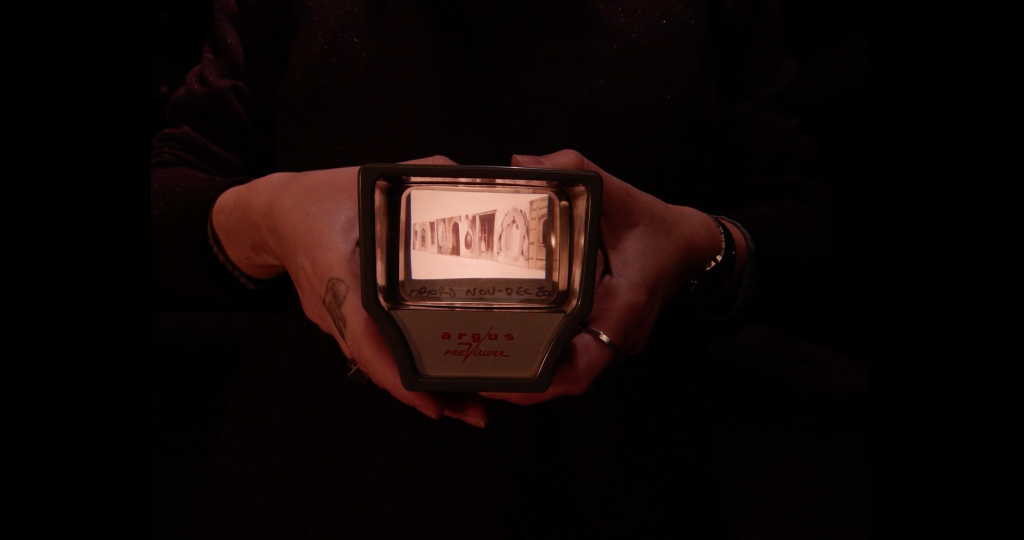Maria Carvajal A Look at the Archival Process

Diapositives de l’espace d’exposition, de A Retake of the Sher-Gil Archives de Vivan Sundaram et de Home/Nation de Rummana Hussein. Réalisées en 2001 par Denis Farley.
As part of an internship in records and archives management
Under the supervision of Denis Lessard, archivist
Archival practice is not always clear in people’s minds. Throughout my certificate, I found myself explaining that archival science is not simply “filing papers.” Archival science is a beautiful profession and obviously more complex than that. I will not discuss information management because, although it shares many aspects and functions with archives management, I see them as two fundamentally different practices. Archives management works with a level of memory that is committed to the preservation of heritage and the need to create a social portrait.
Archivists create tools to help the employees of an institution organize and archive the records that result from their daily activities. Despite this guidance, there are some records that may not be included in these tools, so we will question their value. These are the archives that respond to a personal attachment: “Although the ’emotional’ relationship to the archive is a common thing, this characteristic is not among the aspects that archivists privilege in order to ensure its durability”. [1] For example, drafts, post-it notes, quick sketches when planning an exhibit, and even unconscious scribbles. There is a tendency to keep only the final product and reject the process that is considered “mundane”. This moment is the first level of sorting, the first decision that establishes what will become part of the organization’s history. This moment determines which documents will build the story of an event and how it will be told.
In this short presentation, I want to emphasize the importance of considering these “forgotten” documents as a piece of the story that is worth archiving. At the same time, I take the opportunity to remind you of the media that are often needed to revisit these archives. The obsolescence of media is an issue because with their disappearance, retrieving information is very difficult, even impossible. More than simple “vintage” objects, they are essential to the reading and the enhancement of information held in old media.
The archives selected here come from OBORO’s historical archive collection, more specifically from its 2001-2002 programming. The selected exhibitions are A Profane Practice: Recent Art in India and The Madhouse (Einstein’s Brain Project). The former was part of the event Ideas in Motion: A Contemporary Cultural Dialogue with India, organized by Hoopoe Curatorial. The event took place in three artist-run centers in Montreal, in addition to OBORO. From November 10 to December 15, 2001, OBORO presented the work of three artists from India: Vivan Sundaram, Rummana Hussain and Atul Dodiya. This exhibition was part of a four-year Hoopoe Curatorial project “to establish an artistic and cultural exchange, with a view to creating an awareness of issues shared by Canadian and Indian artists.” [2] The Madhouse (Einstein’s Brain Project) featured the work of Paul Woodrow and Alan Dunning, two artists who have been working with new technologies and media since 1996. The exhibition, which was presented from September 15 to October 20, 2001 as a site-specific installation, “questions our notions of reality by creating and recreating a narrative from an immediate past shared by the participants in the environment. ” [3]
Video taken at the New Media Lab with the help of Aaron Pollard and James Schidlowsky
Many thanks to James for lending his slide viewer.
Video: Maria Carvajal and James Schidlowsky
Video editing: James Schidlowsky
Technical support: Aaron Pollard and James Schidlowsky
Hands: Maria Carvajal
I would like to thank the OBORO team who helped me so much during my internship.

Diapositives de l’espace d’exposition, de A Retake of the Sher-Gil Archives de Vivan Sundaram et de Home/Nation de Rummana Hussein. Réalisées en 2001 par Denis Farley.
Maria Carvajal is a Spanish set designer who has been living in Montreal since 2014. She built her experience in theatres in Madrid and at the Denise Pelletier Theatre in Montreal through the Montreal Arts Council’s démART–Mtl program for the inclusion of culturally diverse artists . Since 2019 she has been supplementing her experiences in the creation and design of spaces with studies in Museology and Archival Studies at UQAM. She has also worked as an assistant to the Artistic Director in several American film productions.
Denis Lessard lives and works in Montreal. Since 1982, he has presented his performances and visual works in Canada, the United States, France and the Netherlands. He holds a MA in art history and a certificate in records and archives management (Université de Montréal, 1985 and 2010). He has also worked as an art critic, translator, guest curator and art history lecturer. Through his interdisciplinary practice, he adresses issues about collecting, male identity, spirituality and the relationship between literature, music and the visual arts. He has participated in a number of residencies in Canada and the Netherlands since 1987. He was awarded the Louis-Comtois Prize in 1994, along with several creation grants from the Canada Council for the Arts, and two travel grants from Conseil des arts et lettres du Québec. Lessard is also a consultant in records and archives management in the area of culture.